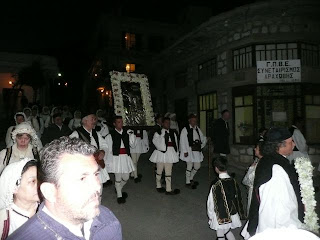We drove south today. Our first stop was an icon workshop only a half hour or so from our starting point. The tour was brief, and the buying long.
 |
| Steps in producing an icon. |
As it was Sunday morning, we stopped briefly at a Greek Orthodox church where services were being held. It was a “low Sunday,” the Sunday after Easter for the Greeks, but the church was packed with people of all ages. We arrived near the end of the service, and they were putting out tea on the veranda outside the narthex. A man there really wanted us to stay and have tea, but we had to get back onto the bus.
 |
| A wide, flat, fertile valley. |
Driving on through a flat, fertile plain with mountains all around provided some interesting scenery. As we began climbing out of the valley into the mountains, the views became spectacular! At a roadside rest stop in the mountains, our tour director surprised us with wine and a snack as we snapped pictures of the view.
 |
| Thermopylae monument. |
On the other side we came to another plain with the Aegean at one end. We stopped briefly here at the monument to 300 Spartans who died fighting invading Persians at Thermopylae. Then we continued climbing another mountain pass, this time coming down to the Corinthian Sea, where we had a lunch break at Itea. The sea was as beautiful on this Ionian side as it was on the Aegean side.
 |
| Seaside at Itea. |
Continuing inland, we drove through the Plain of Apollo, possibly the cradle of Greek civilization, and home to more than 3 million olive trees – the largest planting of olives in Greece, and possibly in the whole Mediterranean region. Although the plots are owned by hundreds of families, the boundaries are subtle, so the appearance is of a single, huge expanse of olive trees going on for miles.
 |
The "Easter Tree," a variety of lilac that blooms
at about Easter time. |
The Plain of Apollo rises toward Mount Parnassus as one goes inland, reaching its end at the ceremonial site of Delphi, which we passed today, but will visit tomorrow.
 |
| The Plain of Apollo with Itea and the Ionian Sea. |
We drove higher yet into the mountains to the village of Arachova and our hotel. The view from our room balcony is breathtaking. We rushed through the evening meal a bit to get into the village. A three-day celebration began this evening to mark the day of Saint George (the same slayer of dragons who is so popular in England) who is the patron saint of the village. We had been told that the celebration would begin about 8:30 p.m. with a procession of the saint’s icon being carried from the church, high on the hill, down to the town center.
 |
| St. George's Day parade |
We found a spot on the parade route. Hundreds of people of all ages – virtually the entire village population – came down the street in two parallel lines, all dressed in traditional Greek costumes. Near the end came the priests in full vestments, including one who was probably the local area bishop, and finally, the icon, carried by four guys.
 |
| The icon of St. George is carried through the village. |
After all of the costumed folk had passed, other town’s people or spectators joined the end of the procession. Mary and I walked with it a ways, but it appeared to be never-ending, so we used our little flashlight to find our way back to the hotel in the dark.









No comments:
Post a Comment